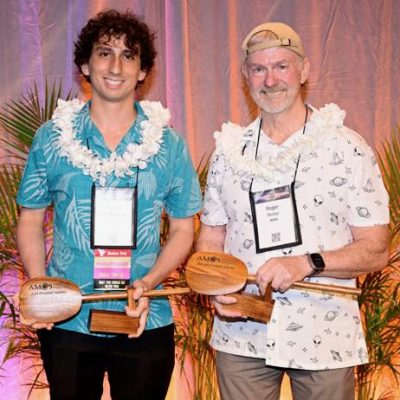Insulin delivery pumps for human spaceflight: Steps toward an accessible space future
Kyle Horn (Human Systems Lab) presents research conducted on a microgravity flight to test an insulin pump in the microgravity conditions of a parabolic flight. This research demonstrates the safety and efficacy of insulin delivery devices in micro- and hypergravity environments. It expands the capability of in-space treatments for endocrine disorders developed by astronauts during long-duration missions while simultaneously advancing the accessibility of human spaceflight for the disabled community.
Horn conducted his research — called Qualifying Insulin Pumps for Spaceflight (QuIPS) — on a zero gravity flight in spring of 2024 as part of the MIT Space Exploration Initiative’s annual research flight. Students who participate in the flight must apply for and successfully complete MAS.838/16.88, Prototyping our Sci-Fi Space Future — a course that guides them through the process of developing a project for zero gravity, co-taught by instructors from the Media Lab and AeroAstro. His research was also supported through the nonprofit AstroAccess, for which Horn is an ambassador.
“Projects like this are critical for advancing the safety and equitability of long-term human exploration in space,” says Horn. “As astronauts spend more time in space, and on missions further from Earth, the likelihood they develop medical complications continues to increase, so testing medical equipment in space-like conditions shows us the gaps in our current technology. Once we know the tech safe to use in space, astronauts with various medical backgrounds will have access to the final frontier of human exploration. It’s a win-win for everyone.”
The long term goal of the project is to qualify insulin pumps for use in space. Horn is continuing to work with AstroAccess to test the pumps in state-of-the-art analog environments and eventually on suborbital and orbital flights to space.
Authors: Kyle Horn and Jeffrey Hoffman
Citation: Journal of Wilderness & Environmental Medicine, January 17, 2025
Abstract
Commercially available insulin pumps for treatment of diabetes mellitus are currently not qualified to operate in the space environment. This work rigorously tested the fluid delivery performance of a Tandem t:slim X2 insulin pump in both micro- and hypergravity during a parabolic microgravity research flight. The parabolic research flight environment serves as an analogue to the types of transient gravitational loadings experienced during human-led missions, which provides a foundation to expand testing to suborbital and orbital flights in addition to other extreme environmental tests for wilderness dependency. The results of the flight data showed no significant difference between fluid delivery performance at 0, 1, and 2g acceleration regimes, nor at the transitions between gravity environments. Recommendations are made for further experimentation and qualification tests before use in future spaceflight missions.



